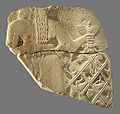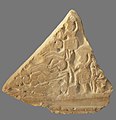Stele of the Vultures
| Stele of the Vultures | |
|---|---|
Musée du Louvre, Paris | |
| Identification | AO 16 IO9, AO 50, AO 2246, AO 2348 |
| Registration | CDLI P222399 |
The Stele of the Vultures is a monument from the
Discovery
The stele is not complete; only seven fragments are known today. The first three fragments were found during excavations in the early 1880s by the French archaeologist
Description
The complete monument, as reconstructed and now in display in the Louvre, would have been 1.80 metres (5 ft 11 in) high, 1.30 metres (4 ft 3 in) wide and 0.11 metres (4.3 in) thick and had a rounded top. It was made out of a single slab of limestone with carved reliefs on both sides.[6] The stele can be placed in a tradition of mid- to late-third millennium BC southern Mesopotamia in which military victories are celebrated on stone monuments. A similar monument is the Victory Stele of Naram-Sin, created during the Akkadian period that followed on the Early Dynastic III period.[7]

The two sides of the stele show distinctly different scenes and have therefore been interpreted as a mythological side and a historical side. The mythological side is divided into two registers. The upper, larger register shows a large male figure holding a mace in his right hand and an
The historical side is divided into four horizontal registers. The upper register shows
The inscriptions on the stele are badly preserved. They fill the negative spaces in the scenes and run continuously from one side to the other. Of the original roughly 840 lines 350 are complete and 130 are partially preserved.
-
Upper register of the "mythological" side
-
Another fragment
-
Detail of the "battle" fragment
-
Detail of the "battle" fragment
-
Reconstruction of the layout of the "historical" side
-
Reconstruction of the layout of the "mythological" side
-
Building funeral mounds, Stele of the Vultures
-
Second scene with Sumerian army
References
- ISBN 978-2-503-53494-7.
- ^ The Cities of Babylonia. Cambridge Ancient History. p. 28.
- ^ Bahrani, Z. 2008. Rituals of war: The body and violence in Mesopotamia, New York: Zone Books.
- S2CID 161359212.
- ^ F. Thureau-Dangin, "Die sumerischen und akkadischen Königsinschriften" (SAKI). Leipzig, pp. 10-21, 1907 (transliteration and translatio
- ^ ISSN 0091-7338.
- ISBN 978-0-521-57568-3.
- ^ van Dijk-Coombes, Renate Marian. "Lions and Winged Things: A Proposed Reconstruction of the Object on the Right of the Lower Register of the Mythological Side of Eannatum's Stele of the Vultures." Die Welt Des Orients, vol. 47, no. 2, 2017, pp. 198–215
- ^ Thorkild Jacobsen, Toward the image of Tammuz and other essays on Mesopotamian history and culture 1970, p. 393; Eva Strommenger, Five thousand years of the art of Mesopotamia 1964 p. 396
- ^ Alster, Bendt. "Images and Text on the 'Stele of the Vultures.'" Archiv Für Orientforschung, vol. 50, 2003, pp. 1–10
- ISBN 978-0-8020-3586-8.
- ISBN 978-2-503-53494-7.
- ^ Découvertes en Chaldée... / publiées par L. Heuzey . 1ère-4ème livraisons / Ernest de Sarzec - Choquin de Sarzec, Ernest (1832-1901). pp. Plate XL.
Further reading
- Nadali, Davide. "How many soldiers on the 'Stele of the Vultures'? A hypothetical reconstruction." Iraq, vol. 76, 2014, pp. 141–48
- Romano, L., La Stele degli Avvoltoi. Una rilettura critica, in Vicino Oriente, XIII, 2007, pp. 205–212, 3–23
- Winter, Irene J. "Eannatum and the 'King of Kish'?: Another Look at the Stele of the Vultures and 'Cartouches' in Early Sumerian Art." Zeitschrift für Assyriologie und vorderasiatische Archäologie 76.2 (1986): 205-212
External links
- The Stele of the Vultures in the Louvre
- Text of the inscriptions on the Stele of the Vultures in: Kramer, Samuel Noah (2010). The Sumerians: Their History, Culture, and Character. University of Chicago Press. pp. 310–312. ISBN 978-0-226-45232-6.








![Inscription "Akurgal king of Lagash, son of Ur-Nanshe" (𒀀𒆳𒃲 𒈗 𒉢𒁓𒆷𒆠 𒌉 𒌨𒀭𒀏).[12][13]](http://upload.wikimedia.org/wikipedia/commons/thumb/d/d1/Akurgal_king_of_Lagash_son_of_Ur-Nanshe_on_the_Stele_of_the_Vultures.jpg/97px-Akurgal_king_of_Lagash_son_of_Ur-Nanshe_on_the_Stele_of_the_Vultures.jpg)